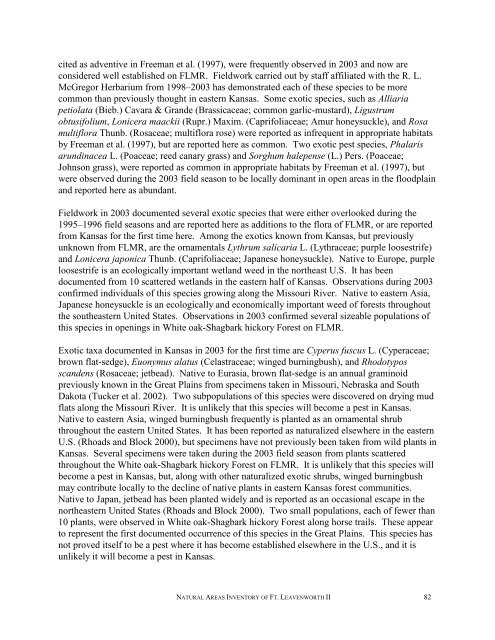A Natural Areas Inventory of the - Kansas Natural Heritage Inventory ...
A Natural Areas Inventory of the - Kansas Natural Heritage Inventory ...
A Natural Areas Inventory of the - Kansas Natural Heritage Inventory ...
Create successful ePaper yourself
Turn your PDF publications into a flip-book with our unique Google optimized e-Paper software.
cited as adventive in Freeman et al. (1997), were frequently observed in 2003 and now are<br />
considered well established on FLMR. Fieldwork carried out by staff affiliated with <strong>the</strong> R. L.<br />
McGregor Herbarium from 1998–2003 has demonstrated each <strong>of</strong> <strong>the</strong>se species to be more<br />
common than previously thought in eastern <strong>Kansas</strong>. Some exotic species, such as Alliaria<br />
petiolata (Bieb.) Cavara & Grande (Brassicaceae; common garlic-mustard), Ligustrum<br />
obtusifolium, Lonicera maackii (Rupr.) Maxim. (Caprifoliaceae; Amur honeysuckle), and Rosa<br />
multiflora Thunb. (Rosaceae; multiflora rose) were reported as infrequent in appropriate habitats<br />
by Freeman et al. (1997), but are reported here as common. Two exotic pest species, Phalaris<br />
arundinacea L. (Poaceae; reed canary grass) and Sorghum halepense (L.) Pers. (Poaceae;<br />
Johnson grass), were reported as common in appropriate habitats by Freeman et al. (1997), but<br />
were observed during <strong>the</strong> 2003 field season to be locally dominant in open areas in <strong>the</strong> floodplain<br />
and reported here as abundant.<br />
Fieldwork in 2003 documented several exotic species that were ei<strong>the</strong>r overlooked during <strong>the</strong><br />
1995–1996 field seasons and are reported here as additions to <strong>the</strong> flora <strong>of</strong> FLMR, or are reported<br />
from <strong>Kansas</strong> for <strong>the</strong> first time here. Among <strong>the</strong> exotics known from <strong>Kansas</strong>, but previously<br />
unknown from FLMR, are <strong>the</strong> ornamentals Lythrum salicaria L. (Lythraceae; purple loosestrife)<br />
and Lonicera japonica Thunb. (Caprifoliaceae; Japanese honeysuckle). Native to Europe, purple<br />
loosestrife is an ecologically important wetland weed in <strong>the</strong> nor<strong>the</strong>ast U.S. It has been<br />
documented from 10 scattered wetlands in <strong>the</strong> eastern half <strong>of</strong> <strong>Kansas</strong>. Observations during 2003<br />
confirmed individuals <strong>of</strong> this species growing along <strong>the</strong> Missouri River. Native to eastern Asia,<br />
Japanese honeysuckle is an ecologically and economically important weed <strong>of</strong> forests throughout<br />
<strong>the</strong> sou<strong>the</strong>astern United States. Observations in 2003 confirmed several sizeable populations <strong>of</strong><br />
this species in openings in White oak-Shagbark hickory Forest on FLMR.<br />
Exotic taxa documented in <strong>Kansas</strong> in 2003 for <strong>the</strong> first time are Cyperus fuscus L. (Cyperaceae;<br />
brown flat-sedge), Euonymus alatus (Celastraceae; winged burningbush), and Rhodotypos<br />
scandens (Rosaceae; jetbead). Native to Eurasia, brown flat-sedge is an annual graminoid<br />
previously known in <strong>the</strong> Great Plains from specimens taken in Missouri, Nebraska and South<br />
Dakota (Tucker et al. 2002). Two subpopulations <strong>of</strong> this species were discovered on drying mud<br />
flats along <strong>the</strong> Missouri River. It is unlikely that this species will become a pest in <strong>Kansas</strong>.<br />
Native to eastern Asia, winged burningbush frequently is planted as an ornamental shrub<br />
throughout <strong>the</strong> eastern United States. It has been reported as naturalized elsewhere in <strong>the</strong> eastern<br />
U.S. (Rhoads and Block 2000), but specimens have not previously been taken from wild plants in<br />
<strong>Kansas</strong>. Several specimens were taken during <strong>the</strong> 2003 field season from plants scattered<br />
throughout <strong>the</strong> White oak-Shagbark hickory Forest on FLMR. It is unlikely that this species will<br />
become a pest in <strong>Kansas</strong>, but, along with o<strong>the</strong>r naturalized exotic shrubs, winged burningbush<br />
may contribute locally to <strong>the</strong> decline <strong>of</strong> native plants in eastern <strong>Kansas</strong> forest communities.<br />
Native to Japan, jetbead has been planted widely and is reported as an occasional escape in <strong>the</strong><br />
nor<strong>the</strong>astern United States (Rhoads and Block 2000). Two small populations, each <strong>of</strong> fewer than<br />
10 plants, were observed in White oak-Shagbark hickory Forest along horse trails. These appear<br />
to represent <strong>the</strong> first documented occurrence <strong>of</strong> this species in <strong>the</strong> Great Plains. This species has<br />
not proved itself to be a pest where it has become established elsewhere in <strong>the</strong> U.S., and it is<br />
unlikely it will become a pest in <strong>Kansas</strong>.<br />
NATURAL AREAS INVENTORY OF FT. LEAVENWORTH II 82


